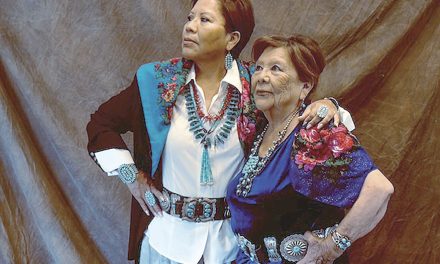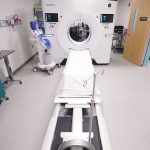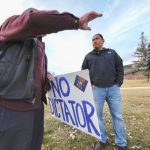
Student tests positive: Despite masks, protocols Piñon schools see first case

Navajo Times | Donovan Quintero
Ella Mike, a bus driver for Piñon Unified School District No. 4, uses an electrostatic fogger to spray the seats and the floor of a bus as she begins disinfecting and thoroughly cleaning after transporting students on Aug. 2, 2021, in Piñon, Ariz.
WINDOW ROCK
Four days after the first day of school at Piñon High, the first COVID-19 case was reported.
The student was immediately placed in the school’s isolation room. A family member was notified and the student was picked up, said Piñon Unified School District Superintendent Chris Ostgaard.
Ostgaard wrote on the school’s website, “The student showed no signs of being ill and had no symptoms. Only later in the day did the student begin showing signs of being sick.
“The test result was positive,” Ostgaard wrote. “Contact tracing was conducted by PHS (Piñon High School) staff, and all students and staff considered a ‘contact’ or ‘exposure’ were notified to be monitored and tested.”
Unlike at the elementary school where barriers were built by faculty using PVC tubing and clear plastic shower curtains, to protect the children sitting at their desks, the high school did not build barriers to protect students.
But that was not a major issue since COVID-19 vaccines are available for children 12 and over.
Ostgaard does not know how the student got the virus and the student did not exhibit any symptoms and passed the school’s screening.
“I believe in the second period and they started to have a headache and have some symptoms,” he said. “So, they said they weren’t feeling well.”
Everyone who was in contact with the student was informed, including classmates. Families were also notified.
Ostgaard said it was recommended symptoms should be monitored everyone should get tested.
Mask mandates, protocols
Students and faculty are required to wear a mask at all times while on school grounds, Ostgaard said, and students are not allowed to leave classrooms during school hours.
“Basically, the students come in, they go to their classrooms, and they spend their day in that room,” Ostgaard said. “They have breakfast in the classroom, lunch in that classroom.
“If teachers need to change, the students stay in one place,” he said. “And the teachers or the staff are the ones that actually rotate and move.”
While the school has pandemic protocols in place that keeps everyone safe inside, the school has no control over what happens off school grounds. So a protocol was created to try to keep the virus out.
Before getting on the bus, if they rode one, or before entering school, everyone is required to have their temperatures checked and answer some questions.
“We have thermometers built into the buses, the infrared, so the student basically just kind of waves their hand at the thermometer and it tells us the temperature,” Ostgaard explained.
“If anybody has an elevated temperature then they’re not allowed to get on the bus,” he said. “They’re basically sent home at that point before they even get to school.”
For students who walk to school, they had to follow the same protocol, said Ostgaard. The only difference is they have to enter from a different door.
Once temperatures are recorded, assuming it’s under 100.4 degrees, they are asked a number of questions such as if they’re feeling sick, if they are experiencing shortness of breath or difficulty breathing, if they are experiencing muscle aches, a sore throat, a headache, a congestion or runny nose, cough, vomiting, diarrhea, or loss of taste or smell.
If they answered “no” to all the questions, they are allowed into the school.
One question the schools are not allowed to ask is if they’ve been vaccinated, said Ostgaard.
“We don’t necessarily know who has been vaccinated and who hasn’t because we’re not really allowed to ask,” he said. “We do have some parents who volunteer that information.”
Under Arizona law, schools cannot require vaccinations of students or staff, he said.
‘I wish we could, but we can’t,” he said. “So, if we just treat everybody as if they’re unvaccinated. They all have the same rules.”
While he isn’t sure how many students 12 and over are vaccinated, Ostgaard said he estimated almost 90% of his staff have been fully inoculated.
Outbreaks, rise in infections
The Navajo Department of Health on Tuesday listed several communities with uncontrolled spread of COVID-19.
Piñon is one of the communities, along with Ganado, Indian Wells, Low Mountain, Teesto, Houck, Manuelito and Rock Springs.
And the Delta variant, which originated in India and is surging across the U.S., is most likely causing a surge in the Navajo Nation, according to Dr. Matthew Clark, an internist and a pediatrician, at Ute Mountain Health Center in Towaoc, Colorado, where he is the clinical director.
Clark, who also serves as chief medical officer for the Alaska Area Native Health Service, as well as chairman for the HIS’s National Pharmacy and Therapeutics Committee, said the Delta variant is “much more highly transmissible” compared to the original SARS-CoV2 strain.
Clark said one person infected with the Delta variant could infect more people compared to the original coronavirus, which he said is less contagious.
But if a person is fully vaccinated, Clark said the person tends to be either asymptomatic or have only mild symptoms.
“They don’t tend to get severe illnesses,” he said.
For that reason, the Centers for Disease Control issued guidance that fully vaccinated people could stop wearing masks indoors and in public spaces because the predominant variant at the time, was the U.K. – or Alpha – variant, with a much lower transmission rate than Delta.
Then in May, the highly contagious Delta variant became the predominant strain among people not fully vaccinated.
Clark said vaccinated people are helping to spread the new strain to unvaccinated individuals
“Unfortunately, we’ve also seen from recent data that those individuals can still spread the virus to others,” he said. “They have a very high amount of what’s called a viral load, a very high amount of viral shedding.
On Monday, bus driver Ella Mike, who trains would-be drivers and helps them attain a commercial driver’s license, or CDL, returned to the Piñon school property after dropping her students off.
That day the school implemented a “mud day” schedule, which meant most of the buses could only drop off the students at the highway near their homes.
Mike parked her bus, capable of transporting eight people, including herself, and said she had to clean the bus, which is part of the school district’s prevention protocol.
“I have to clean it every morning and every afternoon,” Mike said. “Cleaning and disinfecting takes most of the time.”
Mike said she used a cleaning device that resembled a “gun,” which Ostgaard said was called an electrostatic fogger, which she used to spray a disinfecting agent that can kill the coronaviruses.
“We have to wait thirty minutes after we spray it everywhere,” Mike said through her face covering. “Then I close the door, get off, then I wash it off. Even with the longer buses, they have to mop and everything.”
Mike quickly sprayed the inside of her bus and closed the door and said she just had to wait.
In-person learning
Ostgaard said if parents chose not to have their kids attend school for in-person learning, they could choose to do online schooling, which has its own set of challenges.
“We have roughly fifty percent probably of the students, K-12, in our district, have the internet or have, I guess, reliable internet,” Ostgaard said.
“The ones who didn’t have reliable internet, then we did learning packets and workbooks,” he said. “But it was challenging, because those kids that didn’t have the internet weren’t getting a lot of direct instruction.”
Some parents and guardians expressed their thoughts of reopening the schools on the district’s social media page.
“Please take care of our little ones really good,” Martina Manycows Yazzie wrote. “It’s like putting our kids in a line of danger with little to fend for themselves, but they want to return to school.”
Merledine Yazzie also expressed her concerns when she learned a student had tested positive and wrote, “I let my grandkids go back to in-person schooling because I was reassured that the guidelines were going to be strictly followed. This doesn’t look like you’re keeping your word.”
The Piñon Unified School District No. 4 serves about 930 students.
As a public service, the Navajo Times is making all coverage of the coronavirus pandemic fully available on its website. Please support the Times by subscribing.
How to protect yourself and others.
Why masks work. Which masks are best.
Resources for coronavirus assistance








 Highway 264,
Highway 264, I-40, WB @ Winslow
I-40, WB @ Winslow